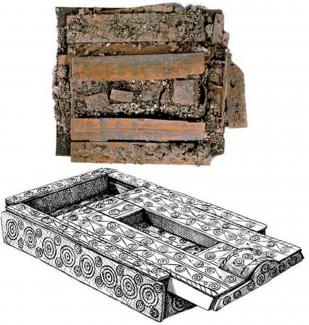Bone inlaid box
Roman, 4th or early 5th century AD
Found during excavations by Winchester Museums Service Archaeology Section at St Martin's Close, Winnall, Winchester in 1984-5
All that remained of this object when it was discovered in the grave of a young woman was the ring-and-dot-decorated bone inlay, as the wooden core had decayed over the centuries. It was possible, though, to reconstruct the box using photographs of the pieces in position next to the head of the deceased.
The bone veneer had been fixed to the box by means of small bone pegs. These also bore traces of decoration, showing that the box had been decorated after its construction. All six faces were veneered, but the lid and the base both had open areas, like two-sided frame. This was probably open originally, even before the wood decayed, as it would have displayed to good advantage the contents of the box- a highly decorated antler comb.
People buried in this part of Winchester's eastern Roman cemetery were rarely given grave goods, but those that have been found are generally of high quality, suggesting a high status group within the population. The way people were buried compares well in some respects with late Roman Christian cemeteries in Mediterranean areas and the Middle East.
Box reconstruction courtesy of English Heritage.



